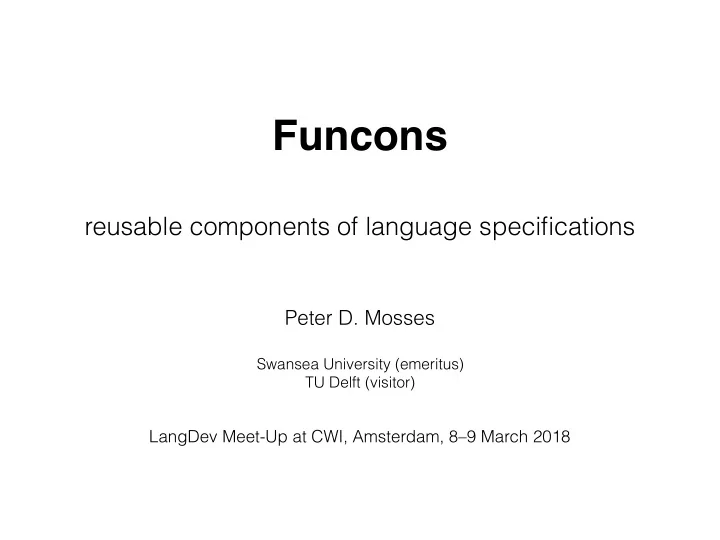

Funcons reusable components of language specifications Peter D. Mosses Swansea University (emeritus) TU Delft (visitor) LangDev Meet-Up at CWI, Amsterdam, 8–9 March 2018
Contents Motivation 3 Funcons 7 Component-based semantics 13 Tool support 22 Demo 25 Conclusion 35 References 47 Note: Slides 31–34 and 40–47 were not presented 2
Specification vs implementation Suppose you were developing a new software language… ‣ would you specify a formal semantics of it? Yes: a few languages from the 80s and 90s ‣ A DA , S CHEME , S TANDARD ML, C ONCURRENT ML No: all other major programming languages ‣ H ASKELL , OC AML , S CALA , J AVA , C#, … (and most DSLs) 3
Funcons Make formal semantics easier than BNF ! Encourage language developers to use formal semantics for: ‣ documentation - language features, design decisions ‣ implementation - rapid prototyping, exploration of design alternatives 4
Conjecture Using a component-based semantic meta-language can significantly reduce the effort of language specification 5
Meta-language engineering Meta-language requirements ‣ clear, concise, expressive notation ‣ solid foundations ‣ tool support for browsing, checking, validating ‣ ease of co-evolution of languages and specifications ‣ reusable components 6
Funcons
Funcons ‣ correspond to fundamental programming concepts ‣ language- independent ‣ have fixed behaviour ‣ specified independently ‣ new funcons can be added 8
Kinds of funcons Computations ‣ Normal: flowing, giving, binding, storing, linking, generating, interacting, … ‣ Abnormal: failing, throwing, returning, controlling, … ‣ (Concurrent: not yet specified) 9
Kinds of funcons Values (some types are built-in) ‣ Primitive: atoms, bools, ints, floats, chars, strings ‣ Composite: algebraic datatypes, tuples, lists, vectors, sets, multisets, maps, pointers, references, variants, … ‣ Abstractions: closures, thunks, functions, patterns, … ‣ none : no-value 10
Recommend
More recommend